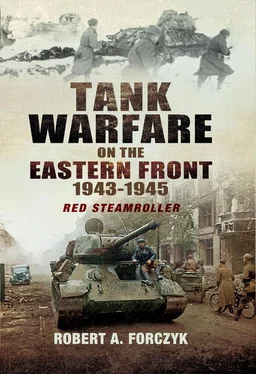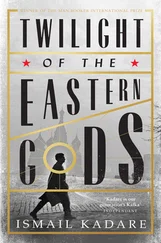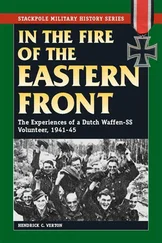By 6 February, both German relief efforts had been halted, 35–40km short of the Korsun pocket. Unlike Stalingrad, Gruppe Stemmermann was in no danger of starving to death, but Soviet pressure on the pocket was inexorably squeezing the defenders and forcing them to consume their ammunition. By 10 February, it was clear that Gruppe Stemmermann could not simply wait for relief and had to take some measures to increase the odds of a link-up with either Breith’s or von Vormann’s forces. Stemmermann decided to reposition his best division, Wiking , to be prepared to attack toward III Panzerkorps at the appropriate moment. SS-Brigadeführer Otto Gille’s Wiking had about 20 operational tanks (Pz III/IV) and several assault guns, as well as 47 artillery pieces (including 9 Wespe and 3 Hummel).
Meanwhile, Breith’s III Panzerkorps was stuck in the mud south of the Gniloi Tikich. Recognizing that Vatutin had blocked his current axis of advance, he decided to regroup and attack eastward, where enemy defences were thinner. By this point, Breith had 140 tanks (incl. 80 Panthers and 12 Tigers) and 14 assault guns. On the morning of 11 February, Breith attacked with Bäke’s heavy tanks in the lead and advanced 8km in two hours. Within five hours, the Panthers had succeeded in capturing a bridge over the Gniloi Tikich at Frankovka. At this point, Breith decided to employ two schwerpunkte in his advance toward Gruppe Stemmermann: Kampfgruppe Bäke would advance northeast while Kampfgruppe Frank from 1. Panzer-Division (one battalion with 28 Panthers and one SPW battalion) would advance east to Lisyanka. With two spearheads advancing toward the pocket, Breith hoped to find weak spots in the Soviet defences. Frank succeeded in capturing Lisyanka in a night attack, before fuel shortages forced both him and Bäke to halt their advance. Both German spearheads were virtually out of fuel and had to waste the next day waiting for the supply units to catch up along the muddy roads. [42]One German supply column moving forward was shot up by Soviet units that had been bypassed in the rapid advance, indicating that Bäke’s lines of communication were not secure.
Vatutin always seemed to have another card up his sleeve and now he introduced General-leytenant Semyon I. Bogdanov’s 2nd Tank Army (3 TC, 16 TC, 11 GTB), which had been in the RVGK until a week before. Bogdanov moved four tank brigades directly into Breith’s path on 12 February, while the German spearheads were immobilized by lack of fuel. The German two-wheel drive Opel Blitz used by the supply echelons were virtually immobilized by the Ukrainian mud and proved to be the Achilles’ Heel of the relief effort. In addition, Kravchenko’s remaining armour and infantry from the 40th Army continued to attack Breith’s exposed flanks, which was a constant irritant. On 13 February, Breith finally had enough fuel to resume his advance and now von Manstein told him that it was ‘now, or never’ – he must reach Gruppe Stemmermann before it was crushed. Bäke advanced with 10 Tigers and 10 Panthers, followed by Kamfgruppe Frank from 1.Panzer-Division. Near the village of Dadushkovka, Bäke’s panzers ran into T-34s from Polkovnik Roman A. Lieberman’s 50th Tank Brigade (3 TC). One platoon of T-34s made the amateur mistake of trying to engage Tigers from a distance of 1,800 meters and paid for this ignorance in blood. However, the other T-34s were more cunning and remained in defilade positions near anti-tank guns, which forced the German panzers to get in much closer, where the T-34s could occasionally score. The tank battle lasted more than an hour, with the Germans claiming another Soviet tank brigade destroyed, but five Tigers and four Panthers were knocked out, leaving Bäke with just 10–11 functional tanks. Although Bäke managed to advance another 12km and reached Khizhintsy, he was still 10km from the pocket and once again out of fuel.
Konev’s forces captured the Korsun airfield on 13 February, abruptly terminating the Luftwaffe airlift. It was clear that Gruppe Stemmermann could only last a few more days. On 14 February, as a desperate expedient, Luftwaffe Ju-52s flew low over his tanks and dropped drums of petrol in the mud, most of which burst. Bäke received just enough fuel to make a small advance, but he could not reach the pocket and he was stopped by intense enemy resistance on Hill 239. That day, the thaw ended and it began to snow again, which hardened the ground. Kampfgruppe Bäke and Kampfgruppe Frank sparred with Bogdanov’s armour near Lisyanka, claiming another 19 T-34s from 5 GTC and some Shermans from 5 GMC, but four Tigers and three Panthers were damaged. With ammunition and fuel nearly exhausted and barely 20 tanks still operational, Breith’s relief effort ground to a halt at Lisyanka on 15 February. Vatutin simply ordered Bogdanov to place more tanks and anti-tank guns to bar any further advance, while the remainder of his forces and Konev’s reduced the pocket. One of the units that arrived to reinforce the 16 TC was Polkovnik Nikolai S. Grishin’s 13th Guards Heavy Tank Regiment, equipped with 21 IS-1 (IS-85) heavy tanks, equipped with the same 85mm D-5T as the KV-85. These heavy tanks were committed into action on 15 February and unwisely attacked Kampfgruppe Bäke instead of sitting on the defence; the Panthers and Tigers knocked virtually all of them out. Following this incident, the GABTU resolved to upgrade the new IS-series heavy tanks to the 122mm gun.
Finally recognizing that relief would not arrive in time, Stemmermann resolved to conduct a breakout operation on the night of 16–17 February to reach III Panzerkorps. In order to gain a springboard for the breakout, Stemmermann launched a series of night attacks from 11–13 February which captured the towns of Shanderovka and Nova Buda from the besieging 27th Army. Attacking at night wearing winter camouflage uniforms, the German infantry caught the Soviet trops by surprise and succeeded in getting a bit closer to III Panzerkorps at Lisyanka. During the day, Konev attempted to retake these towns, but Wiking’s last tanks and assault guns, led by SS-Sturmbannführer Hans Köller, fought them off and defended the breakout assembly areas. {17}
Kampfgruppe Frank and Kampfgruppe Bäke made one last push to Oktaybr on 16 February, destroying part of another Soviet tank brigade but losing more Tigers and Panthers in the process. Frank’s Panthers encountered KV-85s from the 13th Guards Heavy Tank Regiment, attacked to the 16 TC, which was an unpleasant surprise. {18} Gruppe Stemmermann’s lines were 7km away. Stemmermann’s breakout began at 2300 hours on 16 February and initially went quiet well, as infantry from the 72.Infanterie-Division infiltrated through the Soviet cordon, which was held by elements of 5 GTA. However, the Soviets soon detected the breakout and all hell broke loose as the night sky was lit by flares and artillery fire. Wiking tried to break out with 11,500 troops, seven tanks and three assault guns, but was engaged by Soviet tanks and anti-tank guns. Although the combat troops maintained some semblance of discipline, many of the support troops panicked and scattered, or caused traffic jams with the vehicle columns. Stemmermann was killed in the stampede and Soviet cavalry appeared out of the woods to cut up the rear echelons. Thousands of German troops reached the Gniloi Tikich River on foot and were forced to cross this obstacle, which ended up with hundreds drowned or frozen to death. Soviet tanks fired into the horde at the river’s edge, causing further panic. In the end, 35,199 Germans managed to flee the Korsun pocket and reach III Panzerkorps, but about 19,000 were killed or captured. {19} Gruppe Stemmermann abandoned all its artillery and vehicles in the pocket, including 20 tanks and 30 assault guns. Wiking lost over 3,000 men in the breakout and took six months to refit.
Читать дальше








![John Stieber - Against the Odds - Survival on the Russian Front 1944-1945 [2nd Edition]](/books/405234/john-stieber-against-the-odds-survival-on-the-russian-front-1944-1945-2nd-edition-thumb.webp)



